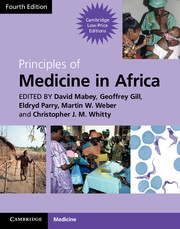Book contents
- Frontmatter
- Contents
- Contributors
- Foreword
- Section 1 Health and disease
- Section 2 Mother and child health
- Section 3 Infection: general principles
- Section 4 Major common infections
- Section 5 Bacterial infections
- Section 6 Viral Infections
- Section 7 Protozoal infections
- Section 8 Helminth infections
- 46 Intestinal helminths
- 47 Schistosomiasis
- 48 Lymphatic filariasis and loa loa
- 49 Onchocerciasis
- 50 Cysticercosis
- 51 Hydatid disease
- 52 Paragonimiasis
- 53 Trichinellosis
- 54 Guinea worm
- Section 9 Fungal infections
- Section 10 Non-communicable diseases
- Section 11 Diseases of body systems
- Section 12 Cancer and Palliative Care
- Section 13 Venoms and Poisons
- Index
- References
54 - Guinea worm
from Section 8 - Helminth infections
Published online by Cambridge University Press: 05 March 2013
- Frontmatter
- Contents
- Contributors
- Foreword
- Section 1 Health and disease
- Section 2 Mother and child health
- Section 3 Infection: general principles
- Section 4 Major common infections
- Section 5 Bacterial infections
- Section 6 Viral Infections
- Section 7 Protozoal infections
- Section 8 Helminth infections
- 46 Intestinal helminths
- 47 Schistosomiasis
- 48 Lymphatic filariasis and loa loa
- 49 Onchocerciasis
- 50 Cysticercosis
- 51 Hydatid disease
- 52 Paragonimiasis
- 53 Trichinellosis
- 54 Guinea worm
- Section 9 Fungal infections
- Section 10 Non-communicable diseases
- Section 11 Diseases of body systems
- Section 12 Cancer and Palliative Care
- Section 13 Venoms and Poisons
- Index
- References
Summary
The problem in Africa
This disease has been transformed since the third edition of this book, thanks to the magnificent efforts of the campaign to eradicate guinea worm and the committed endeavour of thousands of villager volunteers. What was regarded as an inevitable part of village life is now only a memory for many. Families which were economically crippled, because the active farming members were physically crippled by painful ulcers on their legs, can now produce more food, thanks to a safe source of water (bore-hole, well, stand-pipe or other protected source) or, more often, the use of cloth filters. At current rates of progress, the disease should be eradicated by 2019 (Tayeh and Cairncross 2007) provided control measures do not break down. In the past, millions of people were disabled annually by this infection and suffered much economic loss in countries from Senegal to Uganda.
Organism and life cycle
Humans are infected with Dracunculus medinensis when they swallow water containing infected Cyclops, a small crustacean. The infective larvae of the worm break out of Cyclops within the gastrointestinal tract and pass into the subcutaneous connective tissue. Male and female worms mature within the connective tissues in about a year. After fertilization, the small male worm dies and is absorbed. The adult female worm, which grows to some 60 cm long, migrates in the subcutaneous tissues, usually to the feet and legs, parts of the body most likely to come into contact with water. The release of fluid containing hundreds of thousands of larvae causes a skin bleb which ruptures, producing an ulcer, from which the worm is gradually expelled (Fig. 54.1). On contact with water, numerous larvae are released. Having discharged her larvae, the female worm dies.
- Type
- Chapter
- Information
- Principles of Medicine in Africa , pp. 476 - 478Publisher: Cambridge University PressPrint publication year: 2013



